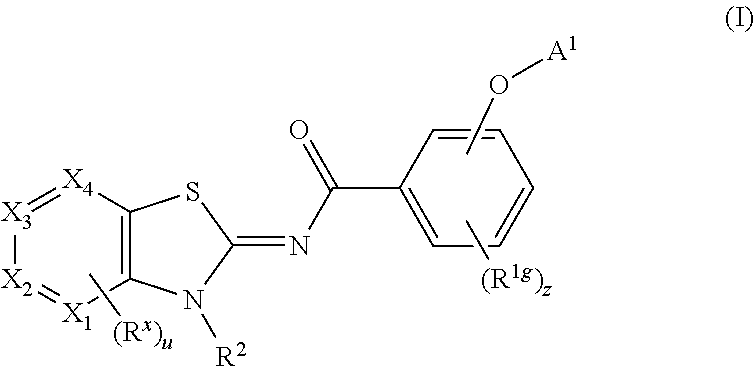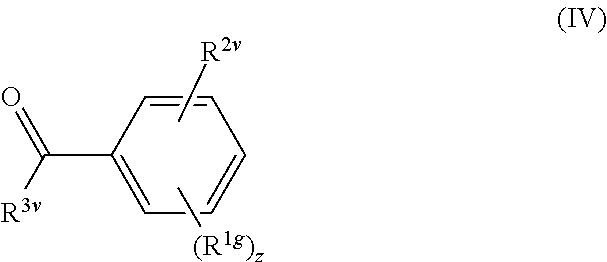Process for preparing cannabinoid receptor ligands
a cannabinoid receptor and processing technology, applied in the field of preparation of cannabinoid receptor ligands, can solve the problem that the overall low yield of the procedure does not have utility for large-scale synthesis
- Summary
- Abstract
- Description
- Claims
- Application Information
AI Technical Summary
Problems solved by technology
Method used
Image
Examples
example 1
N-[(2Z)-3-butyl[1,3]thiazolo[4,5-c]pyridin-2(3H)-ylidene]-2-{[(2R)-2-hydroxypropyl]oxy}-5-(trifluoromethyl)benzamide
Part A: Preparation of N-[(2Z)-3-butyl[1,3]thiazolo[4,5-c]pyridin-2(3H)-ylidene]-2-fluoro-5-(trifluoromethyl)benzamide Hydrochloride salt
[0167]
[0168]To a three-necked flask were charged potassium thiocyanate (200.0 g, 2.03 mol), and tetrahydrofuran (6.78 L). 2-Fluoro-5-(trifluoromethyl)benzoyl chloride (471.0 g, 2.07 mol) was added into the flask slowly at room temperature. The reaction mixture was stirred at room temperature for 5 hours or until less than 1% of the acid chloride remains. The reaction mixture was filtered to remove potassium chloride by-product, and rinsed with tetrahydrofuran (about 0.5 L). The combined solution of 2-fluoro-5-(trifluoromethyl)benzoyl isothiocyanate was charged back to the three-necked flask, followed by addition of N-butyl-4-chloropyridin-3-amine (266.0 g, 1.44 mol). The reaction mixture was heated to approximately 50° C., and stirred...
example 2
N-[(2Z)-3-butyl[1,3]thiazolo[4,5-c]pyridin-2(3H)-ylidene]-2-{[(2S)-2-hydroxypropyl]oxy}-5-(trifluoromethyl)benzamide
Part A: N-[(2Z)-3-butyl[1,3]thiazolo[4,5-c]pyridin-2(3H)-ylidene]-2-{[(2S)-2-(methoxymethoxy)propyl]oxy}-5-(trifluoromethyl)benzamide
[0175]
[0176]To a 250 mL three-necked flask were charged sodium tert-butoxide (97%, 0.69 g, 7.0 mmol), and anhydrous tetrahydrofuran (17 mL). The mixture was stirred, and cooled down to about 0° C. A solution of (S)-2-(methoxymethoxy)propan-1-ol (0.96 g, 8.0 mmol) in THF (2.0 mL) was added slowly at the internal temperature 3PO4 aqueous solution was added slowly to the reaction mixture at 1H-NMR (DMSO-d6) δ 0.94 (3H, t, J=7.4 Hz), 1.24 (3H, d, J=5.9 Hz), 1.41 (2H, m), 1.81 (2H, m), 3.23 (3H, s), 4.08 (3H, m), 4.52 (2H, t, J=7.5 Hz), 4.60 (1H, d, J=6.6 Hz), 4.75 (1H, d, J=6.9 Hz), 7.28 (1H, d, J=8.8 Hz), 7.75 (1H, d, J=8.8 Hz), 7.94 (1H, d, J=5.2 Hz), 8.24 (1H, d, J=2.2 Hz), 8.44 (1H, d, J=5.2 Hz), 8.95 (1H, s). 13C-NMR (DMSO-d6) δ 13.51, 1...
example 3
Preparation of N-[(2Z)-3-butyl[1,3]thiazolo[4,5-c]pyridin-2(3H)-ylidene]-2-(2-hydroxy-2-methylpropoxy)-5-(trifluoromethyl)benzamide
[0179]
[0180]To a 250 mL three-necked flask were charged sodium tert-butoxide (97%, 0.99 g, 10 mmol), and anhydrous tetrahydrofuran (18 mL). The mixture was stirred, and cooled down to about 0° C. A solution of 2-methylpropane-1,2-diol (1.08 g, 12 mmol) in anhydrous tetrahydrofuran (2.0 mL) was added slowly at the internal temperature 3PO4 aqueous solution was added slowly to the reaction mixture at 1H-NMR (CDCl3-DMSO-d6) δ 0.94 (3H, t, J=7.4 Hz). 1.25 (6H, s), 1.42 (2H, m), 1.84 (2H, m), 3.90 (2H, s), 4.48 (2H, t, J=7.4 Hz), 7.08 (1H, d, J=8.7 Hz), 7.62 (1H, dd, J=8.7, 2.3 Hz), 7.70 (1H, d, J=5.3 Hz), 8.32 (1H, d, J=2.3 Hz), 8.39 (1H, d, J=5.3 Hz), 8.73 (1H, s); 13C-NMR (CDCl3-DMSO-d6) δ 13.28, 19.53, 25.92, 29.20, 45.20, 68.79, 77.69, 114.07, 116.74, 120.98 (q, J=33 Hz, C—CF3), 123.21 (q, J=268 Hz, CF3), 125.51, 128.12, 128.65, 132.26, 132.64, 134.74, 1...
PUM
 Login to View More
Login to View More Abstract
Description
Claims
Application Information
 Login to View More
Login to View More - R&D
- Intellectual Property
- Life Sciences
- Materials
- Tech Scout
- Unparalleled Data Quality
- Higher Quality Content
- 60% Fewer Hallucinations
Browse by: Latest US Patents, China's latest patents, Technical Efficacy Thesaurus, Application Domain, Technology Topic, Popular Technical Reports.
© 2025 PatSnap. All rights reserved.Legal|Privacy policy|Modern Slavery Act Transparency Statement|Sitemap|About US| Contact US: help@patsnap.com



